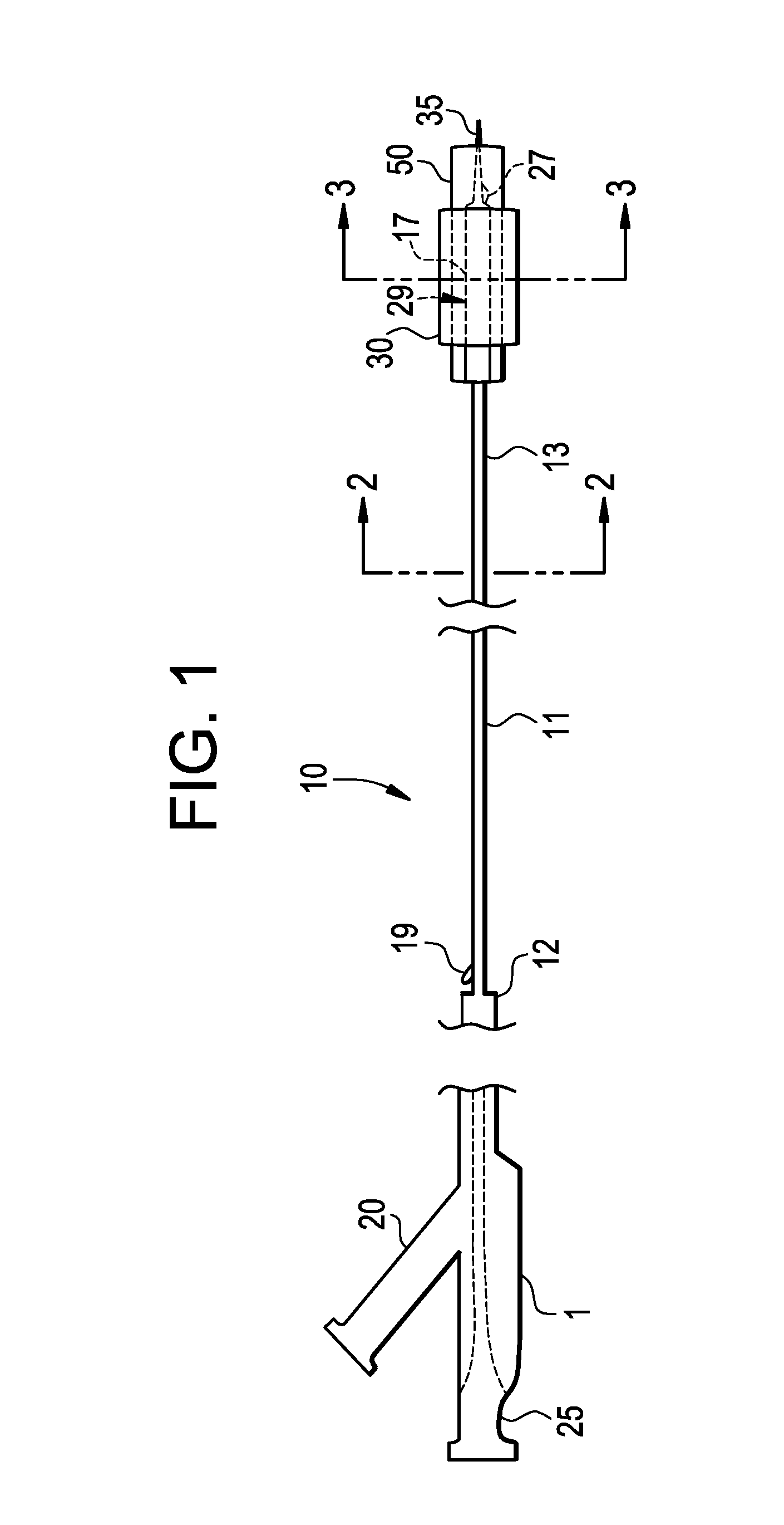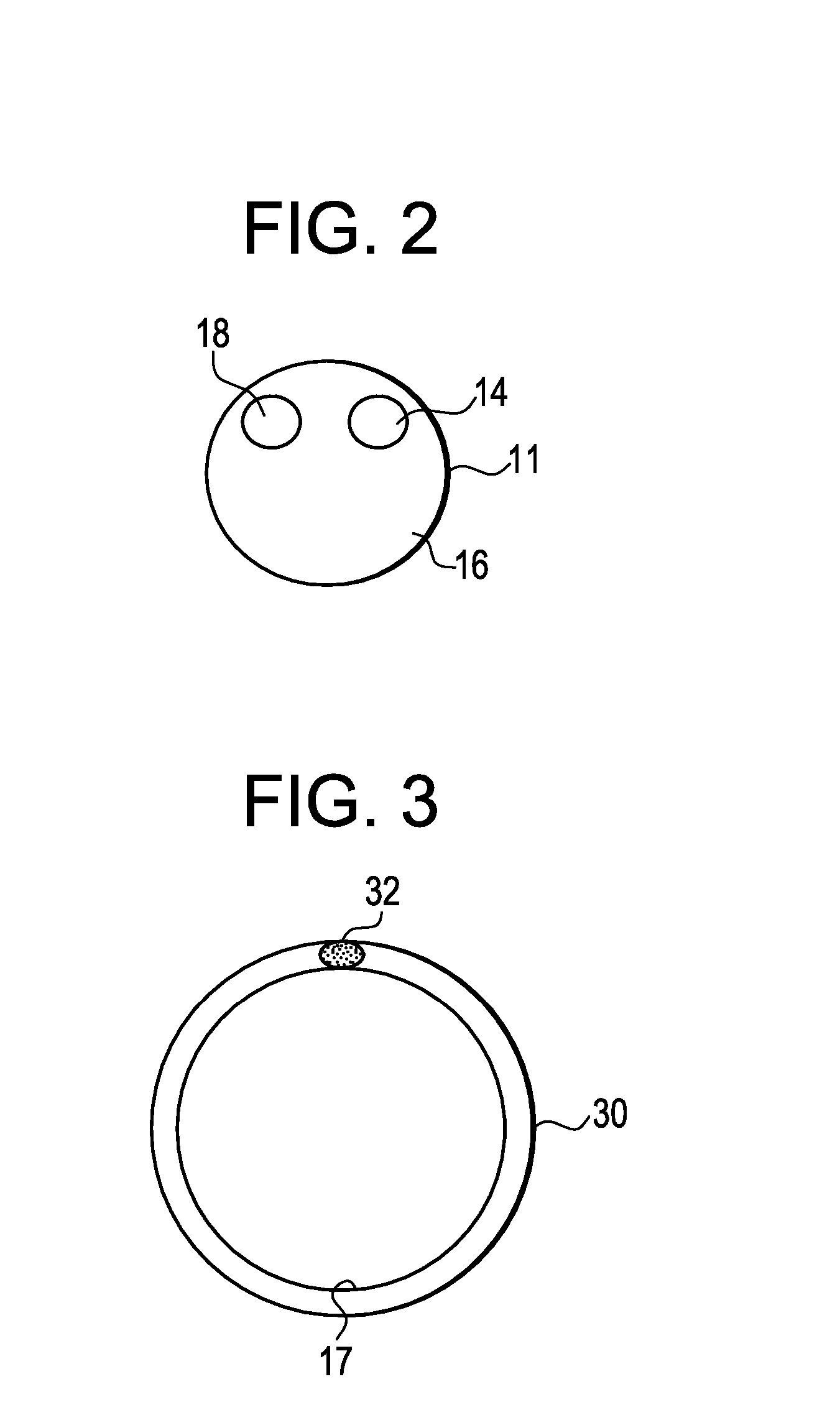[0009] The present invention is directed to a
system and method for the delivery of a medically useful payload to a
target site within a patient's body. By way of example, the
system may be a flexible
catheter, and the medically useful payload may be a
stent or
atherectomy device. In these instances, the medically useful payload is delivered to
a site of
disease within a
blood vessel of a patient. In yet other examples the medically useful payload may be a camera, a light, or both, which can be carried to a site where observation is warranted for purposes of making a
medical diagnosis. In one aspect of the present invention, an orienting region exhibiting a curved shape is located at a distal end of the delivery device. The curved shape facilitates rotation of the payload into a desired position during delivery according to its preferential orientation. That is, the orienting distal region is curved or bent in a preferred direction that causes the device to rotate in accordance with the shape of the vessel or guidewire (if possessing a curved segment) on which the delivery device may be tracked in order to achieve desired orientation of the payload.
[0011] In another aspect of the present invention, the orienting member having a curved shape is distally located on the delivery device and is coupled thereto to allow a degree of torsional movement of the orienting member, relative to other parts of the device. That is, the orienting member is attached to the delivery device in a manner that allows the orienting member to rotate as necessary to orient the member and conform the distal end of the device, where the member is located, to the shape of the vasculature, in order to deploy or carry the payload so the payload can be properly oriented.
[0014] The curved shape imparted to the orienting member of the present invention facilitates orientation of the device as it travels through (1) curves or bifurcations in the vessel, (2) curves or bends in the guidewire, or (3) other eccentricities located within the vessel that create a curved path. So long as the orienting member possesses a sufficient degree of freedom to rotate, it will assume the path of least resistance in the course of its travels, and thereby rotate / orient itself to conform to the curve in the vessel in a unique, repeatable and predictable manner. Thus, by linking or associating a payload with the orienting member in a known relative position, orientation of the payload can be attained as a result of the rotational action exhibited by the orienting member.
[0015] Aside from being adapted to pass relatively easily through bends and curves in the vasculature, the self-orienting member can be used in a number of beneficial ways. Stents deployed at the site of or in the vicinity of a bifurcation may have asymmetrical design features intended to conform to the bifurcation, and in particular, the
side branch ostium. Such stents must be deployed in the proper orientation, a result that can be obtained by
coupling such stents to the orienting member, and then allowing the member to orient itself in the vessel. Likewise, a camera or other diagnostic tool, such as an
ultrasound transducer (IVUS), pressure
transducer,
infrared sensor,
endoscope lens coupled to the orienting member could be properly oriented as a result of orienting member orientation. Furthermore, the self-orienting nature is useful where the curve, so to speak, is imparted by the guidewire that passes through the
catheter. For instance, the orienting member may travel over a guide wire passed into a bifurcation
side branch, allowing a stent to be deployed, in its proper orientation, in the side
branch. In yet another example, a guidewire having a pre-bent or curved section can be used to effect orientation of the orienting member in situations where vessel characteristics are not of an orientation-producing nature. In other words, by positioning the bend in the guidewire at the desired location, the orienting member will orient itself as it traverses the bend. This arrangement is advantageous where it is desirable to achieve orientation in a relatively straight vessel segment. In any event, with these arrangements, rotation of the orienting member for positioning of payload, whether for deployment or other medically useful purpose is facilitated. Further, it should be understood that with the orienting member of the present invention, it is not just the payload that is properly oriented. For example, in the case of a bifurcated vessel, the side
branch guidewire exit port can be oriented to face the
ostium of the side
branch vessel. In other words, as the orienting member rotates, the side branch guidewire exit port aligns according to the orienting member orientation, with the side branch guidewire element facing the side branch ostium. This arrangement makes it possible for the orienting member to properly orient to the side branch
anatomy when the device is seated at the carina of the bifurcation. This arrangement also makes it easier for the side branch guide wire to be advanced out of the delivery
catheter and into the side branch.
 Login to View More
Login to View More  Login to View More
Login to View More 


